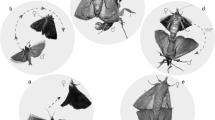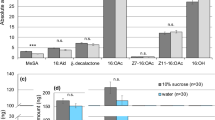Abstract
Hairpencil secretion ofPseudaletia unipuncta (Haw.) contains acetic acid as well as previously identified benzaldehyde and benzyl alcohol. Age-specific titers of acetic acid were significantly greater than those of benzaldehyde and, at 25 °C, accumulation of both compounds in the hairpencils peaked on the second day after emergence. Excised antennae of males and females perceived both compounds. Antennal response to acetic acid did not vary significantly with age or sex, but male response to benzaldehyde was significantly greater than female response at all ages tested. Antennal response of both males and females to benzaldehyde tended to be greater on the fourth and eighth days after emergence than on the second.
Similar content being viewed by others
References
Aplin, R.T., andBirch, M.C. 1970. Identification of odorous compounds from male Lepidoptera.Experientia 26:1193–1194.
Birch, M.C. 1970. Structure and function of the pheromone-producing brush-organs in males ofPhlogophora meticulosa (L.) (Lepidoptera: Noctuidae).Trans. R. Entomol. Soc. London 122:277–292.
Birch, M.C. 1971. Intrinsic limitations in the use of electroantennograms to bioassay male pheromones in Lepidoptera.Nature 233:57–58.
Boeckh, J. 1969. Electrical activity in olfactory receptor cells, pp. 34–51,in Carl Pfaffman (ed.). Olfaction and Taste, Vol. III. Rockefeller University Press, New York.
Boeckh, J., Kaissling, K.-E., andSchneider, D. 1965. Insect olfactory receptors. Cold Spring Harbor Symp. Quant. Biol. 30:263–280.
Cantelo, W.W., andJacobson, M. 1979. Phenylacetaldehyde attracts moths to bladder flower and to blacklight traps.Environ. Entomol. 8:444–447.
Clearwater, J.R. 1975. Pheromone metabolism in malePseudaletia separata (Walk.) andMamestra configurata (Walk.) (Lepidoptera: Noctuidae).Comp. Biochem. Physiol. 50B:77–82.
Davis, E.E. 1986. Peripheral chemoreceptors and regulation of insect behaviour, pp. 243–252,in T.L. Payne, M.C. Birch, and C.E.J. Kennedy (eds.). Mechanisms in Insect Olfaction. Clarendon Press, Oxford.
Farine, J.-P. 1982. Les glandes exocrines mâle et femelle dePseudaletia unipuncta Haw. (Lepidoptera: Noctuidae) et leur rôle dans le comportement précopulatoire des deux sexes.Agronomie 2:459–468.
Fitzpatrick, S.M., andMcneil, J.N. 1988. Male scent in lepidopteran communication: the role of male pheromone in mating behaviour ofPseudaletia unipuncta. Can. Entomol. Mem. 146: In press.
Fitzpatrick, S.M., andMcneil, J.N. 1989. Lifetime mating potential and reproductive success in males of the true armyworm,Pseudaletia unipuncta (Haw.) (Lepidoptera: Noctuidae).Func. Ecol. In press.
Fitzpatrick, S.M., Miller, D., Weatherston, I., andMcneil, J.N. 1985. Determining pher omone content of hairpencils from individual virgin males ofPseudaletia unipuncta (Haw.) (Lepidoptera: Noctuidae).J. Chem. Ecol. 11:207–215.
Fitzpatrick, S.M., Mcneil, J.N., andDumont, S. 1988. Does male pheromone effectively inhibit competition among courting true armyworm males (Lepidoptera: Noctuidae)?Anim. Behav. 36:1831–1835.
Grant, G.G. 1971. Electroantennogram responses to the scent brash secretions of several male moths.Ann. Entomol. Soc. Am. 65:1428–1431.
Grant, G.G., Brady, U.E., andBrand, J.M. 1972. Male armyworm scent brush secretion: Identification and electroantennogram study of major components.Ann. Entomol. Soc. Am. 65:1224–1227.
Hirai, K. 1980. Male scent emitted by armyworms,Pseudaletia unipuncta andP. separata (Lepidoptera: Noctuidae).Appl. Entomol. Zool. 15:310–315.
Hirai, K., Shorey, H.H., andGaston, L.K. 1978. Competition among courting male moths: Male-to-male inhibitory pheromone.Science 202:644–645.
Kevan, P.G., St. Helens, S.D., andBaker, I. 1983. Hummingbirds feeding from exudates on diseased scrub oak.Condor 85:251–252.
Lehninger, A.L. 1975. Biochemistry, 2nd ed. Worth Publishers, New York.
Nagai, T., Starratt, A.N., McLeod, D.G.R., andDriscoll, G.R. 1977. Electroantennogram responses of the European corn borer,Ostrinia nubilalis, to (Z)- and (E)-11-tetradecenyl acetates.J. Insect Physiol. 23:591–597.
Priesner, E. 1979. Progress in the analysis of pheromone receptor systems.Ann. Zool. Ecol. Anim. 11:533–546.
Seabrook, W.D., Hirai, K., Shorey, H.H., andGaston, L.K. 1979. Maturation and senescence of an insect chemosensory response.J. Chem. Ecol. 5:587–594.
Shorey, H.H., andHale, R.L. 1965. Mass rearing of nine noctuid species on a simple artificial medium.J. Econ. Entomol. 58:522–524.
Turgeon, J.J., andMcneil, J.N. 1982. Calling behaviour of the true armyworm,Pseudaletia unipuncta.Entomol. Exp. Appl. 31:402–408.
Turgeon, J.J., Mcneil, J.N., andRoelofs, W.L. 1983. Responsiveness ofPseudaletia unipuncta males to the female sex pheromone.Physiol. Entomol. 8:339–344.
Author information
Authors and Affiliations
Additional information
Lepidoptera: Noctuidae.
Rights and permissions
About this article
Cite this article
Fitzpatrick, S.M., Mcneil, J.N. & Miller, D. Age-specific titer and antennal perception of acetic acid, a component of malePseudaletia unipuncta (Haw.) hairpencil secretion. J Chem Ecol 15, 641–648 (1989). https://doi.org/10.1007/BF01014707
Received:
Accepted:
Issue Date:
DOI: https://doi.org/10.1007/BF01014707




